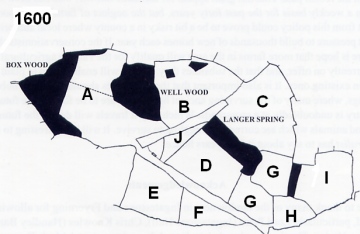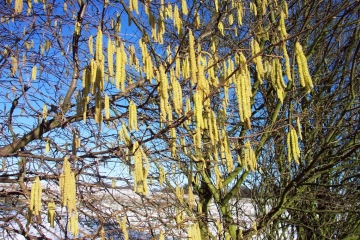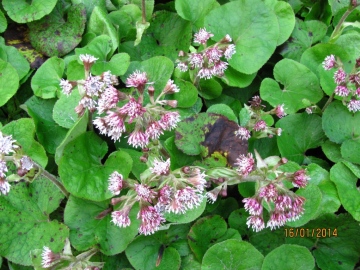Sir William’s son, John (later the first Lord Petre), commissioned a map of the estate from two of the leading cartographers of the day, John Walker and his son, also John. That depicted demesne land attached to Handley Barns Manor as including Redindyke Farm, properties at nearby Handley Green, and what are now called Mill Green Common and Stoneymore Wood but which at the time were known as Handley Common and Great Handley Wood. In time, Common and woods became part of the Writtle Park estate, purchased by Sir William from Queen Mary in 1554. Handley Barns Farm though has changed very little in the five centuries since then. In 1600 the farm comprised around 130 acres of meadow and pasture and three small ancient woodlands, Box & Well Woods and Langer Hedge. The first two remain, the last has gone, but was replaced in the late 16th or early 17th centuries with Gust Leaze, later renamed Bushy Wood. Field boundaries have been tweaked and land use has changed in line with agricultural fortunes (the marshy meadows alongside a stream have recently been replaced by the largest in a series of fishing lakes) but in 2014 it is essentially the same farm as in 1600 and quite possibly 1066 as well, or even earlier. One of the fields on the farm is a designated Roman site, possibly concealing the remains of a villa, and finds there in the past have included coins depicting Hadrian (117-138), Marcus Aurelius (161-180) and the latter’s wife, Faustina, who does not appear to have been a very nice person at all, to put it mildly! This is what makes Handley Barns a very special place.
 (The letters refer to field names. Field G, for instance, was once known as Thistly Field and two hundred years or so on is still full of thistles - and Goldfinches and butterflies - each autumn).
(The letters refer to field names. Field G, for instance, was once known as Thistly Field and two hundred years or so on is still full of thistles - and Goldfinches and butterflies - each autumn).
When I was at primary school in the 1950s we had a teacher for a few months called Dave Sorrel. One day he took us for a walk to Box Wood and we spent a couple of hours happily rooting around in the leaf litter digging up shards that had been dumped from a pottery which had once existed on an adjoining farm. On returning to school we cleaned the shards and he identified them for us, teaching us a little about the era in which they had been made. If I had but realised it at the time he prised open a window on a subject that interested me; a window that was slammed firmly shut in Secondary School but which, in later life, was flung wide when I stumbled across the books of Oliver Rackham. These were a revelation. There was I, a country boy through and through, who had walked the parish fields and woods hundreds of times with his parents when a youngster, and bird-nesting friends as a boy, yet was completely unaware that the landscape I was walking in had a history. Suddenly, woods and meadows, hedgerows, pollards, ponds and coppice stools had context and meaning. Not only that but the plants that grew in them, the birds that nested in them, the butterflies and moths that supped nectar from their flowers and whose caterpillars fed on their leaves, the dragonflies that danced above the ponds; even the mushrooms that I picked in the meadows, all were inextricably linked to the history of the landscape in which they lived. Birds had always been my ‘thing’ since I was knee high to a grasshopper but Oliver’s books opened my eyes and broadened my interest so that natural history and human history became indivisible. A walk would never be the same again. I cannot thank the Professor profusely enough!
This will teach you to pay me compliments……………………………
Anyway, Handley Barns was where I was today, completing a Winter Thrush Survey for the British Trust for Ornithology. Birds have had it easy this winter compared with last, when three months of unrelenting easterlies from the Russian Arctic killed so many. Ground nesting birds such as thrushes have benefited from all the rain; worms, forced to the surface, almost giving themselves up so sodden is the soil. They and other birds are already looking forward to the spring. Blackbirds are becoming territorial, Blue Tits are busily courting and Song Thrush, Mavis, Tom Tit, Redbreast, Hedge-e-Bet and Jenny Wren are all in song. Bluebells, Daffs and Cuckoo Pint are pushing through the mud; Snowdrops are in bloom in the village gardens; Hazel catkins are shedding sheets of pollen on the breeze
 and Winter Heliotrope, like these in Back Lane, are blooming at several sites in the village close to houses. Let’s hope this winter does not have too nasty a sting in its tail.
and Winter Heliotrope, like these in Back Lane, are blooming at several sites in the village close to houses. Let’s hope this winter does not have too nasty a sting in its tail.

And finally, you never stop learning, or at least you shouldn’t. I have even learned to love Brussel Sprouts, after refusing to go near them as a kid unless they were buried in Bubble & Squeak. What I do not seem to have learned is that if you trip or slip while sauntering along with your hands in your pockets the first thing to hit the ground is likely to be your nose! Oh well, at least the ground was soft today…………………


















